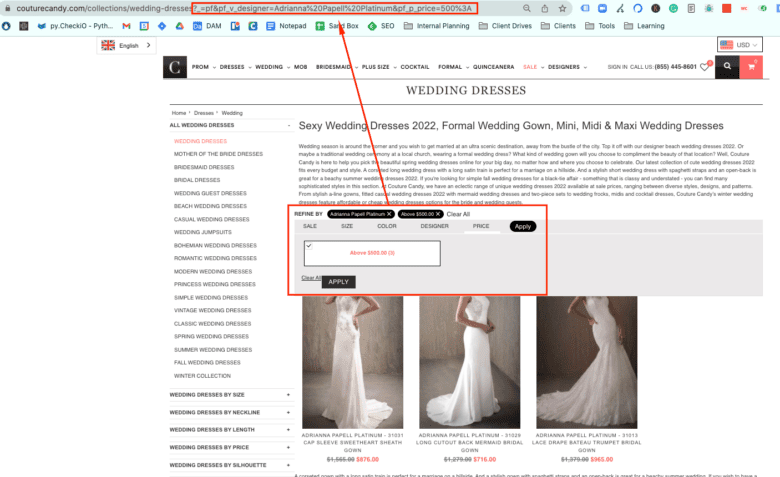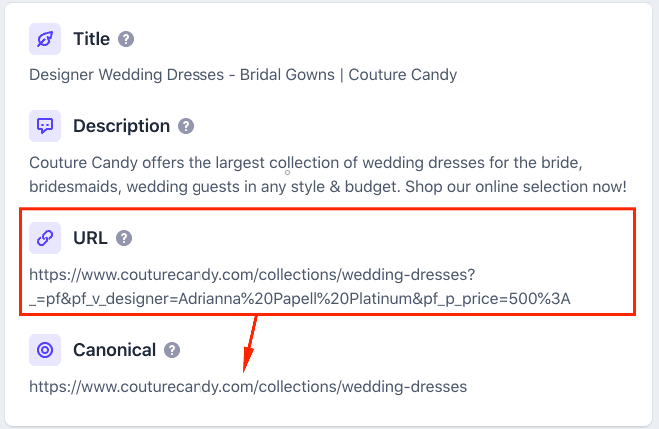If your eCommerce website sells a lot of products, there’s nothing like faceted navigation to improve your customers’ search experience. Sorting by filters like size, color, and style can greatly increase conversion rates — but, unless you set up the technical aspects correctly, that could easily be negated by harmful SEO impacts.
Fortunately, faceted navigation isn’t as tricky as it seems, as long as you follow a few important rules.
In this blog, we’ll cover everything your online business needs to know, including:
- What faceted navigation is
- How it can affect your SEO performance
- And which strategies you need to follow for best results
Let’s get started.
What is Faceted Navigation?
Faceted navigation (also known as faceted search) is a type of navigation typically found on the sidebar or at the top of category and collection pages of online retailers. Faceted navigation is achieved through the selection of certain “filters” (which differ from technical filters on a site, but that’s a discussion for another blog), such as brand, color, price range, or any other product attributes you want to include.
This type of navigation greatly benefits your customers, especially for large websites. Rather than having to search through countless results in each category, your shoppers can narrow down your products with their desired filtering options and more quickly find what they’re looking for.
There is one common functionality that, if not handled correctly, could become a disadvantage for your site’s SEO performance. Typically, when a customer applies a filter to their search, your website will automatically apply a parameter to the category URL, as seen in this example from our client Couture Candy. Typically, these URL parameters are additions like ?price=10, ?dir=asc, or other qualifiers.

How This Can Impact SEO
Not only are faceted navigation URLs pretty ugly to look at, but they can also do harm to your search engine optimization if left unchecked.
The last thing you want is for these faceted pages to be indexed by search engines like Google, but it happens more often than you think. (Trust us: We’ve done the audits.)
Here’s why these URLs can be so harmful:
1. Duplicate Content
When your shoppers apply facets while browsing, they create new URLs for your site — but the content on those pages often remains the same from URL to URL. And, when the same content is indexed with different URLs, your site runs the risk of being dinged for duplicate content.
Duplicate content penalties can confuse Google’s algorithm (as to which pages should rank) or, in the worst-case scenario, can lead to your webpages being removed from the search results altogether.
Note: You’ll also see duplicate page content occur when internal search results pages are indexed, as similar identifiers are added to the end of category page URLs.
2. Index Bloat
Depending on the size of your eCommerce store, faceted navigation URLs can add hundreds or thousands of more URLs to your website. When those pages are allowed to be indexed by Google, you get what’s known as index bloat.
This large number of indexed, low-quality pages can slow down your site and negatively affect user experience, not to mention waste valuable SEO opportunities (more on that next).
Index bloat is one of the biggest indicators that your site has issues with modified URLs, either from faceted navigation, internal site searches, or other factors. If, for example, your site only has 10,000 valuable pages, but Google Search Console shows an indexed number of pages nearing 38,000, you’ve got a problem — and it’s time for your team to take another look.
3. Wasted Crawl Budget
If you have index bloat on your site, you’ll likely also have wasted crawl budget.
Google dedicates a certain amount of “energy” reviewing every single site on the internet. Exactly how much time its crawlers spend reviewing an individual site is known as “crawl budget.”
Because crawl budget is limited, you want to ensure yours is being used on the most important pages of your website, like category and product pages. Faceted navigation URLs definitely shouldn’t make the cut.
Unfortunately, if you don’t have the right setup, multitudes of these URLs generated by your customers can sneak onto Google’s list, stealing its attention away from the pages that you do want to be indexed.
Best Practices for eCommerce Faceted Navigation
Of all the questions we get about this aspect of technical SEO, it all boils down to one big query:
Are we doing it right?
Short of diving into your Google Search Console and combing the SERPs for any wonky site URLs, there are three strategies we recommend for properly implementing faceted navigation — and preventing the negative SEO impacts discussed above.
1. Canonical Parameter URLs to Main Category Page
The most straightforward way to ensure your filtered or faceted navigation URLs don’t appear in the SERPs is by using the proper canonical tag.
No matter what unique parameters or identifiers show up in the URL when a shopper browses your site, in most cases, you want the base URL to reflect the main category page.
In the example below, see how the URL in question includes faceted parameters (?=pf&pf_v_designer=…). The canonical tag instead directs to the main category page, with that parameter removed.

By telling search engines that your canonical URL is the equivalent of the faceted URL, the main category page becomes the default page to be indexed.
2. Noindex Parameter URLs
Alternatively, you can choose to add a noindex tag to all of these pesky navigation URLs (whether related to facets, filters, or internal site searches).
By adding “noindex” to your meta robots tag in the head of each faceted URL, you will help stop the indexing of that page.
3. Use Robots.txt
If your navigation URLs all follow a similar, unique format (like using ?= before a navigational identifier), you could also use robots.txt file to block Googlebot and other search engines from crawling them all with one fell swoop.
Use a disallow rule in conjunction with the unique parameter of your navigational pages.
Don’t Forget to Use a Plugin
Faceted navigation is typically added to an eCommerce site by using a plugin. These apps automatically create filtered URLs, identify them as they appear, and (ideally) apply the correct canonical tags or noindex tags to them automatically.
Not all plugins available on an eCommerce platform may provide the best results. And, because we don’t conduct hands-on research for each of the plugins that come out, we can’t recommend individual applications at this time.
Instead, we suggest you research your options, choose one that promises to work for your platform, give it a shot, and evaluate the results. (Our team is happy to give a quick once-over before and after implementation, to ensure everything looks okay.)
If your chosen plugin fails to work in the desired manner, scrap it and give another one a try.
Here are a few resources to start your research:
- 5 Best WordPress Search Filter Plugins Compared | HeroThemes
- Wix Stores: Adding Filters & Sorting Options to Your Product Gallery
- How to Implement Faceted Search in WordPress | Exemplify
- Add Storefront Filtering | Shopify
For more faceted navigation fixes, check out Ahrefs’ extensive guide.
Revisit Your Faceted Navigation Now
Whether your eCommerce site has been using faceted navigation for years, or you’re considering implementing it for the first time, using the right SEO approach will save you a great deal of wasted time and effort.
In a nutshell, here’s what you need to do:
- Look at your indexed page reports and/or research your brand in the organic search results pages (SERPs) to identify any parameter URLs.
- Find a faceted navigation plugin that will work for your website platform.
- Implement the plugin and ensure it uses best practices with the help of your development team.
- Wait a few days, and then repeat the first step to find any outstanding offenders.
If you’re not sure where your faceted navigation stands (or how to find it in the first place), our team is always here to help. Request a free technical audit anytime by contacting our SEO experts today.





